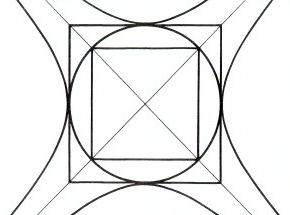Mandala
Franklin Merrell-Wolff’s Mandala1
A mandala is a unique symmetrical or quasi-symmetrical archetypal symbol of wholeness, generally having a concentric, counterbalanced geometric form. It functions as an aid to unify disparate elements and to center consciousness in a nonspatiotemporal Oneness. In its proper sense, it “takes its inspiration from the mystic longing for supreme integration.
Franklin Merrell-Wolff’s mandala (middle image above) consists of two squares, one inscribed within a circle and the other circumscribing the circle, with two conjugate hyperbolas that touch the four points where the circle and exterior square coincide. The perfect symmetry of the form about both axes shows a simple elegance that is absent in more visually elaborate mandalas. He notes that its circularity and fourfoldness satisfy the usual conditions for a mandala; however, whereas most mandalas are aesthetic, this instead is conceptual and theoretical. Moreover, he suggests that we consider it three-dimensionally, in terms of a sphere, an inscribed and a circumscribed cube, and six cone-like hyperbolic arms—a feat which requires mathematical intuition, rather than a visual perspective.
Franklin developed his mandala from his third realization, “Substantiality is inversely proportional to ponderability, using the mathematical interpretation S = 1/P to represent it conceptually—or, by multiplying both sides by P, it becomes PS = 1. Where S and P are variables, this has the form xy = 1, the equation for an equilateral hyperbola, where x and y are the axes of a graph using Cartesian coordinates. To conform to the typical orientation of mandalas, he rotated the axes by 45°, transforming the equation for the hyperbola to x2 – y2 = 2, where the horizontal and vertical axes are now the standard x-axis and y-axis. For balance and fourfold symmetry he added the conjugate hyperbola x2 – y2 = -2. However, he left both axes and asymptotes (the lines between the arms of the hyperbola that intersect at the origin touch at infinity) implicit in the final form, shown above.
The genesis of his mandala began with his third realization, but within a few weeks he had undergone his two Fundamental Realizations-each of which was profoundly transformative. Although the geometrical form of Franklin’s mandala is quite simple, he required several years to complete its composition for the reason that the development of the outward form reflects the inner process of psychical integration.
Not only must the significance of each part of a mandala be understood in itself, it must be understood in relation to the whole. Furthermore, because every mandala originates in the unconscious and is expressed through an individual, that is the person whose interpretation is most immediate. We are indebted to Franklin for the interpretative treatment that he left.
To understand the symbolism of this mandala we must begin with the circle, the square and the hyperbola individually, and how they are related. Each of these three geometric forms represents an orientation of consciousness. Overall, the mandala has two orientations of consciousness, related to each of Franklin’s two Fundamental Realizations, respectively. The first reflects the usual centering function of a mandala; the second—the orientation to infinity—is a unique transformative function.
The circle symbolically encompasses the world—whatever appears within human experience, but especially the cycles of nature. The square represents conceptuality—our rational capacity to understand the phenomena of experience by ideation, logical ordering and language. The hyperbola represents the nonphenomenal—that which transcends the empirical domain.
The archetypes of the circle and the square are very familiar. Traditionally, the circle symbolizes the eternal domain transcending time and ordinary subject-object consciousness. For Franklin, however, he notes that tracing the circle is an endless action, for there is no unique point where it begins or ends. The circle thus represents the dynamic causally conditioned processes of nature—periodicities of the world unfolding within time and space. The circumference of the circle signifies the objective never-ending flow of phenomena, whereas the center signifies the Pure Subject, Self or Atman—a dimensionless point whose position is known only with reference to the circumference.
The center of a circle is related to its circumference as the perspective that the pure subjective moment of consciousness has on the object of awareness. For the circle, the center is emphasized, both geometrically—by exemplifying a uniquely symmetrical form, perfectly balanced—and psychologically, in the attempt to apprehend it, by drawing consciousness inward toward the center within the horizon of the circumference. It is perhaps not coincidental that Franklin developed his mandala by adding elements one by one toward the center.
In contrast to the circle, which represents the dynamic flux of the empirical domain, the square represents the unchanging, static realm of the forms. Because these are logically prior to experience, their definitions and interrelationships are determinate and immutable. Instead of the organic processes of nature, we are now dealing with the dualistic processes of consciousness that move toward a systematic organization of a conceptual understanding of human experience. The square thus represents measurement, definition, conceptual distinction, determination, analysis and synthesis within a dualistic framework.
Franklin views the interior square as representing an orientation to thought that is essentially scientific, insofar as it is based on exact measurement and articulation by concepts that are precisely defined. However, because the circle extends beyond the boundaries of this square, it indicates that the scientific mode of thought cannot know the whole of nature with an exhaustive determination.
The conceptuality symbolized by the exterior square is both more subtle and more comprehensive, inasmuch as it encompasses the natural phenomena represented by the circle, but is also open to the indeterminate transcendent domain through the point of contact with the hyperbolas. As such, it represents a region of thought where only partial determination using definable concepts is possible, increasing its scope at the cost of determinateness. We see, then, that the inner square signifies the mode of scientific thought and language, whereas the outer square signifies a symbolic mode of thought and its distinctive way of expression.
The interrelationship of circle and square, whether inscribed or circumscribed are well-known themes from antiquity. The subtle significance of the mandala is the esoteric significance of the ancient problem (never merely geometric) of squaring the circle. It is essentially the attempt to unite opposites—a creative restructuring of apparently antithetical elements in a higher order synthesis. Franklin interprets it symbolically as striving to assimilate the Transcendent into the relative, dualistic consciousness.
The hyperbolas of Franklin’s mandala coincide with the circle at four points, indicating that the phenomenal world and the Transcendent are absolutely distinct realms, or modes of consciousness, but that there is a potential to shift from one side to the other of the discontinuity. Moreover, the hyperbolas touch the outer square at the same points as for the circle, but because they extend entirely beyond the square, they lie in the indeterminate domain, where only symbolic expression may be possible.
The circle represents a restricted dualistic domain oriented to the center, where consciousness is drawn into, and centered within, the self, and is bounded by the phenomenal world of which it is aware. In contrast, the hyperbola represents consciousness transcending the polarized structure of self-world. It opens outward and is oriented to infinite space, its arms extending indefinitely in a curve that closes only at infinity. Thus, in the attempt to apprehend it, consciousness is drawn toward and embraces infinity.
In Franklin’s mandala, the symbolic value of the hyperbola is critical in inverting the usual function of focusing consciousness toward the center, where its significance typically increases with inward movement. This would be the case where his mandala symbolizes Realization of the Self (his first Fundamental Realization), as this is his first, but not most important, intention. It is the hyperbolic opening to infinity in all directions that effectively reverses this valuation, increasing the Transcendental significance as one moves outward from the center. It is impossible to draw this mandala fully because the arms of the hyperbola and the field that they encompass are infinite. Relative consciousness cannot grasp it by either senses or reason, but as a symbol of Liberation that induces a mode of consciousness oriented to the inexhaustible possibility of Space, it may be Known. Thus the hyperbola infuses Franklin’s mandala with a subtle power such that the effect of contemplating it is potentially transformative.
Franklin derives the ultimate symbolic significance of his mandala from his final, and most profound, Fundamental Realization—the High Indifference. It arises from, and points back to, the transcendent, nondualistic Consciousness-without-an-Object and without-a-Subject. The primary orientation of his mandala is to the GREAT SPACE, and its function is to bring whoever contemplates it to that Realization.
Text by Ron Leonard ©2011


